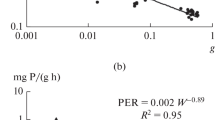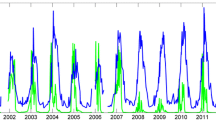Abstract
The metabolic strategies of the polychaete Marenzelleria viridis (Verrill 1873), a successful immigrant into Baltic shallow eutrophic coastal waters with meso-to oligohaline salinities since the 1980's, were determined by simultaneous calorimetry and respirometry. Resistance to oxygen deficiency under varying ecological conditions was also examined. The results of the studies with this immigrant were compared to those with the common indigeneous polychaete Nereis (Hediste) diversicolor (O.F. Müller). At 10 and 20 °C and the average habitat salinity of 5‰ M. viridis gradually reduced its metabolic activity with declining oxygen partial preessures (pO2), whereas H. diversicolor maintained its metabolic activity. The metabolism of both species remained fully aerobic down to a pO2 of 2 kPa. An additional hyposmotic stress of 0.5‰ salinity at a temperature of 20 °C led to a decrease in the rate of oxygen consumption in H. diversicolor below a pO2 of 10 kPa, whereas metabolic heat dissipation remained constant. M. viridis, however, further reduced both, metabolic heat dissipation and oxygen consumption. The metabolic rates of both species under anoxia were similar, amounting to ca. 20% of the normoxic rate. The resistance of the two species to oxygen deficiency was also similar, ranging between 21 and 290 h (median survival time LT50), depending on temperature and salinity. Specimens used in the present study were collected from the Southern Baltic coastal inlet of “Darß-Zingster-Boddenkette” during 1992 and 1993.
Similar content being viewed by others
References
Arndt EA (1989) Ecological, physiological and historical aspects of brackish water fauna distribution. In: Ryland JS, Tyler PA (eds) Proc 23rd eur mar Biol Symp Swansea UK. Olsen & Olsen, Fredensborg, pp 327–338
Beis I, Manousis A, Barrett J (1980) Studies on the respiration of the polychaete Ophelia bicornis. Comp Biochem Physiol 67A: 303–305
Bestwick BW, Robbins IJ, Warren LM (1989) Metabolic adaptations of the intertidal polychaete Cirriformia tentaculata to the life in an oxygen-sink environment. J exp mar Biol Ecol 125:193–202
Bick A, Burckhardt R (1989) Erstnachweis von Marenzelleria viridis (Polychaeta, Spionidae) für den Ostseeraum, mit einem Bestimmungsschlüssel der Spioniden der Ostsee. Mitt zool Mus Berl 65(2):237–247
Bochert R, Bick A, Zettler M, Arndt EA (1994) Marenzelleria viridis (Verrill, 1873) (Polychaeta: Spionidae) an invader in the benthic community in Baltic coastal inlets-investigations of the reproduction. In: Andrushaitis A (ed) Proc of the 13th BMB Symposium, Riga 1994 (in press)
Cammen LM (1987) Polychaeta: In: Pandian TJ, Vernberg FJ (eds) Animal energetics, Vol 1. Academic Press, San Diego, pp 217–260
Dales RP, Warren LM (1980) Survival of hypoxic conditions by the polychaete Cirriformia tentaculata. J mar biol Ass UK 60: 509–516
Dauer EM, Ewing RM, Tourtellotte GH, Baker Jr HR (1980) Nocturnal swimming of Scolecolepides viridis (Polychaeta: Spionidae). Estuaries 3:148–149
Doeller JE, Kraus DW, Colacino JM (1990) Simultaneou measurement of the rates of heat dissipation and oxygen consumption in marine invertebrates having and lacking hemoglobin. Comp Biochem Physiol 97A(2):107–113
Essink K, Kleef HL (1988) Marenzelleria viridis (Verril, 1873) (Polychaeta: Spionidae): a new record from the Ems Estuary (The Netherlands/Federal Republic of Germany). Zool Bijdr 38:3–13
Fritzsche D, von Oertzen J-A (1995) Bioenergetics of a highly adapable brackish water polychaete. Thermochim Acta (in press)
Gnaiger E (1983a) Calculation of energetic and biochemical equivalents of respiratory oxygen consumption. In: Gnaiger E, Forstner H (eds) Polarographic oxygen-sensors. Springer Verlag, Berlin, pp 337–345
Gnaiger E (1983b) Heat dissipation and energetic efficiency in animal anoxibiosis: economy contra power. J exp Zool 228:471–490
Gnaiger E (1991) Animal energetics at very low oxygen: information from calorimetry and respirometry. In: Woakes R, Grieshaber M, Bridges CR (eds) Strategies for gas exchange and metabolism. Soc Exp Biol Seminar Ser 44. Cambridge University Press, London, pp 149–171
Gnaiger E, Staudigl I (1987) Aerobic metabolism and physiological responses of aquatic oligochaetes to environmental anoxia: heat dissipation, oxygen consumption, feeding and defecation. Physiol Zool 60(6):659–677
Hammen CS (1983) Direct calorimetry of marine invertebrates entering anoxic states. J exp Zool 228:397–403
Hardewig I, Addink ADF, Grieshaber MK, Pörtner HO, v d Thillart G (1991) Metabolic rates at different oxygen levels determined by direct and indirect calorimetry in the oxyconformer Sipunculus nudus. J exp Biol 157:143–160
Hoffmann AA, Parsons PA (1989) An integrated approach to environmental stress tolerance and life-history variation: desiccation tolerance in Drosophila. Biol J Linn Soc 37:117–136
Hohendorf K (1963) Der Einfluß der Temperatur auf die Salzgehaltstoleranz und Osmoregulation von Nereis diversicolor O.F. Muell. Kieler Meeresforsch. XIX(2):196–218
Kinne O (1971) 4 Salinity. 4.3. Animals. 4.3.1. Invertebrates. In: Kinne O (ed) Marine ecology, Vol 1. Environmental factors. Wiley, London, pp 821–995
Kristensen E (1983a) Ventilation and oxygen uptake by three species of Nereis (Annelida: Polychaeta). I. Effects of hypoxia. Mar Ecol Prog Ser 12:289–297
Kristensen E (1983b) Comparison of polychaete (Nereis spp.) ventilation in plastic tubes and natural sediment. Mar Ecol Prog Ser 12:307–309
Lampert W (1984) The measurement of respiration. In: Downing JA, Rigler FH (eds) A manual on methods for the assessment of secondary productivity in fresh waters. IBP Hand Book 17, Oxford, pp 413–468
Llansó RJ (1991) Tolerance of low dissolved oxygen and hydrogen sulphide by the polychaete Streblospio benedicti (Webster). J exp mar Biol Ecol 153:165–178
Mangum CP (1978) Temperature adaptation. In: Mill PJ (ed) Physiology of annelids. Academic Press, London, pp 447–475
Mangum CP, van Winkle W (1973) Responses of aquatic invertebrates to declining oxygen conditions. Am Zool 13:529–541
McLusky DS, Hull SC, Elliot M (1993) Variations in the intertidal and subtidal macrofauna and sediments along a salinity gradient in the upper Forth estuary. Neth J aquat Ecol 27:101–109
Nausch G, Schlungbaum G (1991) Eutrophication and restoration measures in the Darß-Zingst bodden chain. Int Revue ges Hydrobiol 76:451–463
Newell RC, Branch GM (1980) The influence of temperature on the maintenance of metabolic energy balance in marine in vertebrates. Adv mar Biol 17:329–396
Oeschger R (1990) Long-term anaerobiosis in sublittoral marine invertebrates from western Baltic Sea: Halicryptus spinulosus (Priapulida), Astarte borealis and Arctica islandica (Bivalvia). Mar Ecol Prog Ser 59:133–143
Oeschger R, Peper H, Graf G, Theede H (1992) Metabolic responses of Halicryptus spinulosus (Priapulida) to reduced oxygen levels and anoxia. J exp mar Biol Ecol 162:229–241
Pamatmat MM (1983) Measuring aerobic and anaerobic metabilism of benthic infauna under natural conditions. J exp Zool 228: 405–413
Pedersen TF (1991) Metabolic adaptations to hypoxia of two species of Polychaeta, Nephtys ciliata and Nephtys hombergii. J comp Physiol (Sect B) 161:213–215
Pörtner HO, Grieshaber MK (1993) Critical pO2 (s) in oxyconforming and oxyregulation animals: gas exchange, metabolic rate and the mode of energy production. In: Eduardo J, Bicudo PW (eds) The vertebrate gas transport cascade-adaptations to environment and mode of life. CRC Press, Boca Raton, pp 330–357
Pörtner HO, Heisler N, Grieshaber MK (1985) Oxygen consumption and modes of energy production in the intertidal worm Sipunculus nudus L: definition and characterization of the critical pO2 for an oxyconformer. Respir Physiol 59:361
Schöttler U, Daniels D, Zapf K (1990) Influence of anoxia of euryhaline polychaetes to hyposmotic conditions. Mar Biol 104: 443–451
Schöttler U, Grieshaber MK (1988) Adaptation of the polychaete worm Scoloplos armiger to hypoxic conditions. Mar Biol 99: 215–222
Schöttler U, Wienhausen G, Zebe E (1982) Der Einfluß des Sauerstoffgehaltes auf den Modus der Energiegewinnung bei marinen Polychaeten. Verh dt zool Ges 1982:331
Schöttler U, Wienhausen G, Zebe E (1983) The mode of energy production in the lugworm Arenicola marina at different oxygen concentrations. J Comp Physiol 149:547
Shumway SE (1979) The effects of body size, oxygen tension and mode of life on the oxygen uptake rates of polychaetes. Comp Biochem Physiol 64A:273–278
Smith RI (1970) Chloride regulation at low salinities by Nereis divesicolor (Annelida, Polychaeta). I. Uptake and exhanges of chloride. J exp Biol 53:75–92
Theede H, Ponat A, Hiroki K, Schlieper C (1969) Studies on the resistance of marine bottom invertebrates to oxygen-deficiency and hydrogen sulphide. Mar Biol 2(4):325–337
Theede H (1973) Comparative studies on the influence of oxygen deficiency and hydrogen sulphide on marine bottom invertebrates. Neth J Sea Res 7:244–252
Theede H, Schaudinn J, Saffé F (1973) Ecophysiological studies on four Nereis species of the Kiel Bay. Oikos (Suppl) 15: 246–252
Toulmond A, Tchernigovtzeff C (1984) Ventilation and respiratory gas exchange of the lugworm Arenicola marina (L.) as functions of ambient pO2 (20–700 torr). Respir Physiol 57:349–363
Vismann B (1990) Sulfide detoxification and tolerance in Nereis (Hediste) diversicolor and Nereis (Neanthes) virens (Annelida: Polychaeta). Mar Ecol Prog Ser 59:229–238
Wang WX, Widdows J (1991) Physiological responses of mussel larvae Mytilus edulis to environment hypoxia and anoxia. Mar Ecol Prog Ser 70:223–236
Weber RE (1978) Respiration. In: Mill PJ (ed) Physiology of annelids. Academic Press, London, pp 369–388
Widdows J (1987) Application of calorimetric methods in ecological studies. In: James AM (ed) Thermal and energetic studies of cellular biological systems. Wright, Bristol, pp 182–215
Author information
Authors and Affiliations
Additional information
Communicated by O. Kinne, Oldendorf/Luhe
Rights and permissions
About this article
Cite this article
Fritzsche, D., von Oertzen, JA. Metabolic responses to changing environmental conditions in the brackish water polychaetes Marenzelleria viridis and Hediste diversicolor . Marine Biology 121, 693–699 (1995). https://doi.org/10.1007/BF00349305
Received:
Accepted:
Issue Date:
DOI: https://doi.org/10.1007/BF00349305




